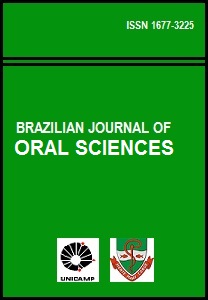Abstract
Periodontitis and osteoporosis, diseases that affect millions of people in world, present bone loss as common hallmark. Prevalence of both osteoporosis and tooth loss increase with advancing age in both women and men. Systemic bone loss has been proposed as a risk factor for periodontal disease with increasing evidences that osteoporosis, and the underlying loss of bone mass characteristic of this disease, is associated with periodontal disease and tooth loss. Periodontitis has long been defined as an infection-mediated destruction of the alveolar bone and soft tissue attachment to the tooth, responsible for most tooth loss in adult populations. Current evidences including several prospective studies support an association of osteoporosis with the onset and progression of periodontal disease in humans. Systemic loss of bone density in osteoporosis, including that of the jaw, may provide a host system that is increasingly susceptible to infectious destruction of periodontal tissue. Studies have provided evidence that hormones, heredity, and other host factors influence periodontal disease’s incidence and severity. This paper reviews the role of estrogen deficiency and osteoporosis in oral bone healthy and the current evidences on the association between periodontal disease and osteoporosis.References
Krall EA, Wehler C, Garcia RI, Harris SS, Dawson-Hughes B. Calcium and vitamin D supplements reduce tooth loss in the elderly. Am J Med. 2001; 111: 452-6.
Krall EA, Garcia RI, Dawson-Hughes B. Increase risk of tooth loss in related to bone loss at the whole body, hip, and spine. Calcif Tissue Int. 1996; 59: 433-7.
Norderyd OM, Grossi SG, Machtei EE, et al. Periodontal status of women taking postmenopausal estrogen supplementation. J Periodontol. 1993; 64: 957–62.
Kanis JA, Melton LJ III, Christiansen C, et al. Perspective: the diagnosis of osteoporosis. J Bone Miner Res. 1994; 9: 1137-41.
Rodan GA, Martin TJ. Therapeutic approaches to bone disease.Science. 2000; 289: 1508-14.
Payne JB, Zacs NR, Reinhardt RA, Nummikoski P. The association between estrogen status and alveolar bone density changes in postmenopusal women with a history of periodontitis. J Periodontol. 1997; 68: 24-31.
M. Tezal, J. Wactawski-Wende, S.G. Grossi , A.W. Ho, R. Dunford, and R. J. Genco. The Relationship Between Bone Mineral Density and Periodontitis in Postmenopausal Women. J Periodontol. 2000; 71: 1492-8.
Krejci CB, Bissada NF. Women’s health issues and relashionship to periodontitis. J Am Dent Assoc. 2002; 133: 323-7.
Reinhardt RA, Payne JB, Maze CA, Patil KD, Gallaghaer SJ, Mattson JS. Influence of estrogen and osteopenia/osteoporosis on clinical periodontitis in postmenopausal women. J Periodontol. 1999; 70: 823–8.
Vaanamen HK. Mechanisms of bone turnover. Ann Med. 1995; 25: 353-9.
Nair SP, Wilson M, Reddi K, White P, Henderson B. Bacterially induce bone destruction: mechanisms and misconceptions. Infect Immun. 1996; 64: 2371-80.
Canalis E. The hormonal and local regulation of bone Formation. Endocr Rev. 1983; 4: 62-77.
Hall TJ, Chambers TJ. Molecular aspects of osteoclast function. Inflamm Res. 1996; 45: 1-9.
Kanis JA, Black D, Cooper C, Dargent P, Dawson-Hughes B, De Laet C, Delmas P, Eisman J, Johnell O, Jonsson B, Melton L, Oden A, Papapoulos S, Pols H, Rizzoli R, Silman A, Tenenhouse A. A new approach to the development of assessment guidelines for osteoporosis. Osteoporos Int. 2002; 13(7): 527-36.
Consensus Conference: From the National Institutes of Health. Osteoporosis prevention, diagnosis, and therapy. J Am Med Assoc. 2001; 285: 785-95.
Lunt M, Felsenberg D, Reeve J, et al. Bone density variation and its effects on risk of vertebral deformity in men and women studied in thirteen European centers: the EVOS Study. J Bone Miner Res. 1997; 12: 1883-94.
Lukert BP, Raisz LG. Glucocorticoid-induced osteoporosis. Ann Intern Med. 1990; 112: 352-64.
Rodino M, Shane E. Osteoporosis after organ transplantation. Am J Med. 1998; 104: 459-69.
Brown LJ, Loë H. Prevalence, extent, severity and progression of periodontal disease. Periodontol 2000. 1993; 2: 57-71. Pilot T, Miyazaki H. Periodontal conditions in Europpe. J Clin Periodontol. 1991; 18: 353-7.
Jonhson RB, Gilbert JA, Cooper RC, Parsell DE, Sewart BA, Dai X, Nick TG, Streckfus CF,. Butler RA, Boring JG. Effect of estrogen deficiency on skeletal and alveolar bone density in Sheep. J Periodontol. 2002; 73: 383-91.
Golub LM, Ramamurthy NS, Llavaberas A, et al. A chemically modified nanotimicroial tetracycline (CMT-8) inhibits gingival matrix metalloproteines, periodontal breakdown, and extra-oral bone loss in ovariectomized rats. ANN NY Acad Sci. 1999; 878: 290-310.
Damoulis PD, Hauschka PV. Cytokines induce nitric oxide production inmouse osteoblasts. Biochem Biophys Res Commun. 1994; 201: 924-31.
Streckfus C.F, Johnson RB., Nick T, Tsao A, Tucci M. Comparison of alveolar bone loss, alveolar bone density, salivaryand gingival crevicular fluid interleukin-6 concentrations in healthy premenoapusal and postmenopausal women on estrogen therapy. J Gerontol. 1997; 52A: M343-51.
Manolagas SC, Bellido T, Jilka RL. New insigths into the cellular biochemical and molecular bassis of postmenopausal and senile osteoporosis. Role of IL-6 and gp 130. Int J Immunopharmacol. 1995; 17: 109-16.
Richman MJ, Abarbanel AR. Effects of estradiol, testosterone, diethylstilbesterol and several of their derivatives upon the human mucous membrane. J Am Dent Assoc. 1943; 30: 913–23.
Girasole G, Jilka RL, Paseri G, et al. 17b-estradiol inhibits interleukin-6 by bone marrow-derived stromal cells and osteoblasts in vitro: A potential mechanism for the antiosteoporotic effect of estrogens. J Clin Invest. 1992; 89: 883-91.
Richman MJ, Abarbanel AR. Effects of estradiol, testosterone, diethylstilbesterol and several of thier derivatives upon the human mucous membrane. J Am Dent Assoc. 1943; 30: 913–23.
The Brazilian Journal of Oral Sciences uses the Creative Commons license (CC), thus preserving the integrity of the articles in an open access environment.

